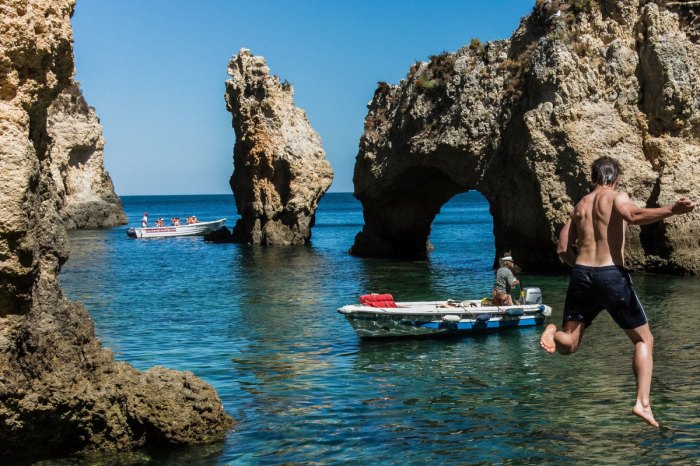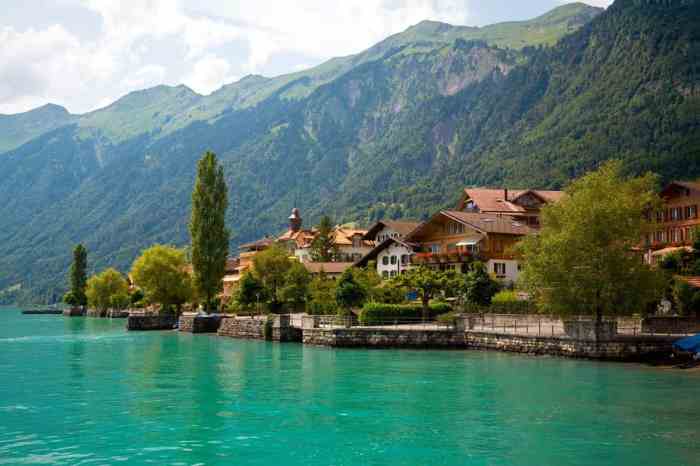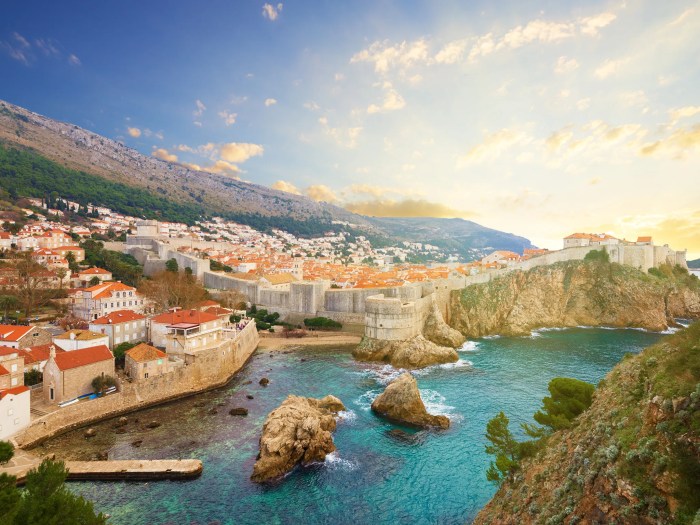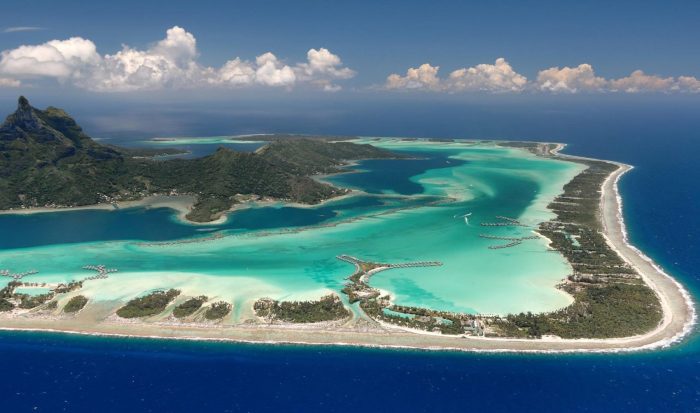Top 10 Cliff Jumping Places Around The World
Top 10 Cliff Jumping Places Around The World: Imagine yourself standing at the edge of a towering cliff, the wind whipping through your hair, the vast expanse of the ocean stretching out before you. A surge of adrenaline courses through your veins as you take the leap, plummeting towards the water below.
This is the exhilarating experience of cliff jumping, an activity that attracts thrill-seekers from all corners of the globe. From the rugged cliffs of Norway to the tropical shores of the Caribbean, there are countless destinations where you can test your limits and experience the ultimate adrenaline rush.
Cliff jumping is a thrilling and exhilarating activity that combines the thrill of heights with the exhilaration of plunging into the cool waters below. But it’s important to remember that cliff jumping is not without its risks. Safety should always be your top priority, and it’s essential to choose locations with appropriate heights and water depths.
This article will guide you through the top 10 cliff jumping spots around the world, providing insights into their unique features, safety considerations, and tips for maximizing your experience. So, buckle up and get ready to take the plunge!
Introduction: Top 10 Cliff Jumping Places Around The World
Cliff jumping, a thrilling and adrenaline-pumping activity, involves leaping from a high cliff into a body of water below. This adventurous pursuit offers a unique blend of excitement and exhilaration, attracting individuals seeking a rush of adrenaline and a connection with nature.
However, it’s crucial to approach cliff jumping with utmost caution and prioritize safety.
Safety Precautions and Responsible Practices
Responsible cliff jumping requires a thorough understanding of safety measures and adherence to established guidelines.
- Assess the Jump Site:Before taking the plunge, carefully evaluate the cliff’s height, water depth, and surrounding conditions. Look for any potential hazards, such as rocks, debris, or strong currents.
- Check Water Depth:Ensure the water is deep enough to prevent injury upon impact. A general rule of thumb is to aim for a minimum depth of 10 feet (3 meters) for a safe landing.
- Understand Water Conditions:Be aware of any currents, tides, or waves that could affect your jump. Strong currents can pull you away from the cliff, while waves can create unpredictable conditions.
- Practice Proper Entry Technique:Learn the correct entry technique to minimize the risk of injury. Enter the water feet first, keeping your body straight and arms extended to reduce impact.
- Jump with a Buddy:Always jump with a companion who can provide assistance in case of an emergency. Ensure your buddy is aware of your location and is prepared to react quickly if needed.
- Avoid Alcohol and Drugs:Never jump while under the influence of alcohol or drugs, as this impairs judgment and reaction time, increasing the risk of accidents.
Top 10 Cliff Jumping Spots

Cliff jumping is an exhilarating activity that combines adrenaline-pumping thrills with breathtaking views. It involves leaping from a high cliff into a body of water below. This adventurous activity offers a unique perspective on the world and a chance to test your courage and physical limits.
So you’re looking for the best spots to take the plunge? Cliff jumping is definitely an adrenaline rush, and there are some seriously epic spots around the world. If you’re looking for something a little different, check out the Top 10 Places On The Aeolian Islands – they’re known for their stunning volcanic landscapes and crystal clear waters, which could be the perfect backdrop for your next cliff jump!
Top 10 Cliff Jumping Spots
Cliff jumping can be a rewarding experience, but it’s essential to prioritize safety and choose locations with appropriate conditions. Here are ten popular cliff jumping spots worldwide, each offering unique challenges and stunning scenery.
Looking for a serious adrenaline rush? Check out the Top 10 Cliff Jumping Places Around The World, and if you’re planning a trip to Eastern Europe, you might want to add Russia to your list! You can find some amazing sights in the Top 10 Places To Visit In Russia , and then head back to the cliffs for some epic jumps!
| Location | Country | Height | Description |
|---|---|---|---|
| Victoria Falls | Zambia/Zimbabwe | 108 meters (354 feet) | The world-famous Victoria Falls offers a thrilling cliff jumping experience, with a plunge into the Zambezi River. However, due to the significant height and powerful currents, this is only recommended for experienced jumpers. The falls are surrounded by lush rainforest and offer stunning views. |
| El Salto | Mexico | 25 meters (82 feet) | El Salto, located near Puerto Vallarta, is a popular cliff jumping spot with a series of cliffs ranging in height. The clear blue water and surrounding lush jungle create a picturesque setting. |
| The Cliffs of Moher | Ireland | 214 meters (702 feet) | While not typically known for cliff jumping, the Cliffs of Moher offer a breathtaking view of the Atlantic Ocean. However, jumping from these cliffs is extremely dangerous and not recommended. |
| Preikestolen | Norway | 604 meters (1,982 feet) | Preikestolen, also known as Pulpit Rock, is a flat-topped mountain with a dramatic drop-off. While not specifically designed for cliff jumping, its sheer size and stunning views attract thrill-seekers. |
| Polihale State Park | Hawaii, USA | Variable | Polihale State Park on Kauai Island offers a variety of cliff jumping opportunities along the rugged coastline. The cliffs range in height, providing options for different skill levels. |
| Blue Lagoon | Croatia | 15 meters (49 feet) | The Blue Lagoon on the island of Hvar offers a picturesque cliff jumping spot with crystal-clear turquoise water. |
| Cliffs of Dover | England | 110 meters (361 feet) | The iconic White Cliffs of Dover are known for their historical significance and dramatic views. However, jumping from these cliffs is extremely dangerous and not recommended. |
| La Jolla Cove | California, USA | Variable | La Jolla Cove offers a variety of cliff jumping spots, with varying heights and water conditions. It’s essential to check local regulations and be aware of potential hazards. |
| Cliffs of Étretat | France | Variable | The dramatic cliffs of Étretat, with their iconic rock formations, attract climbers and adventurers. However, cliff jumping is not permitted in this area. |
| The Great Ocean Road | Australia | Variable | The Great Ocean Road offers stunning coastal views and various cliff jumping opportunities. However, it’s crucial to be aware of the unpredictable ocean conditions and potential hazards. |
Safety Considerations
Cliff jumping, while exhilarating, is an inherently dangerous activity that requires careful planning and execution. The allure of soaring through the air and plunging into cool water is undeniable, but it’s crucial to prioritize safety and make informed decisions to avoid potential risks.
Assessing Height and Water Depth
It’s essential to thoroughly assess the height of the cliff and the depth of the water before taking the leap. Jumping from heights that are too high can lead to serious injuries, and shallow water poses a significant risk of impact trauma.
- Use a measuring tape or other tools to determine the cliff’s height.A good rule of thumb is to avoid jumping from heights exceeding 10-15 meters (33-49 feet).
- Carefully examine the water’s depth.Look for any visible obstacles or shallow areas. If unsure, it’s always best to err on the side of caution and choose a different location.
- Consider the water’s clarity and visibility.Turbid water can make it difficult to see the bottom and increase the risk of hitting submerged objects.
Potential Risks and Hazards
Cliff jumping carries inherent risks, including:
- Impact Injuries:Jumping from significant heights can result in severe injuries, such as spinal cord injuries, broken bones, and internal bleeding.
- Drowning:Even strong swimmers can experience difficulties in rough water or if they lose consciousness upon impact.
- Head Injuries:Striking the water headfirst can lead to serious head injuries, including concussions and spinal cord damage.
- Entrapment:If the water is shallow or contains submerged objects, there is a risk of getting trapped or pinned.
- Water Conditions:Strong currents, waves, or underwater hazards can increase the risk of injury or drowning.
Safety Gear and Equipment
While not always mandatory, wearing appropriate safety gear can significantly reduce the risk of injury:
- Life Jackets:Wearing a life jacket is highly recommended, especially for beginners or those jumping from significant heights.
- Helmets:Helmets can protect your head from impact injuries, particularly when jumping from higher cliffs.
- Waterproof Bags:Use waterproof bags to protect valuables like phones, keys, and wallets from getting wet.
Techniques and Tips

Cliff jumping is a thrilling activity, but it’s crucial to approach it with caution and proper technique to ensure a safe and enjoyable experience. Mastering the right techniques can significantly reduce the risk of injury and enhance your overall experience.
Entering the Water
Proper entry into the water is essential for minimizing impact and avoiding injury. Here’s how to do it:
- Body Position:Maintain a streamlined body position with your arms extended above your head, forming a “pencil” shape. This minimizes resistance as you enter the water.
- Hand Placement:Keep your hands together and slightly in front of your head, not too far forward. This helps prevent injuries to your hands and shoulders.
- Entry Angle:Aim for a vertical entry, going straight down into the water. This minimizes the impact force compared to a horizontal entry.
Minimizing Impact and Reducing Risk
- Feet First:Enter the water feet first, allowing your body to naturally distribute the impact. This is the safest and most recommended technique for cliff jumping.
- Keep Your Body Tight:Maintain a tight and streamlined body position throughout the jump. This helps reduce the amount of water resistance you encounter and minimizes the impact force.
- Avoid Twisting or Turning:Entering the water with a twisting or turning motion can increase the risk of injury. Keep your body straight and aligned throughout the jump.
- Practice in Shallow Water:Start by practicing your entry technique in shallow water before attempting higher cliffs. This allows you to get comfortable with the feeling of entering the water.
Assessing Water Conditions and Identifying Hazards
- Water Depth:Ensure the water is deep enough to allow for a safe entry and prevent hitting the bottom. Aim for at least 10 feet of depth, especially for higher jumps.
- Currents:Be aware of any currents that might pull you away from the cliff or towards potential hazards. Avoid jumping in areas with strong currents.
- Rocks and Obstacles:Carefully check the water for any rocks, submerged logs, or other obstacles that could pose a danger. Clear areas are ideal for safe jumping.
- Marine Life:Consider the potential presence of marine life, such as jellyfish or sharks, especially in areas known for these creatures. Research local conditions and take necessary precautions.
Best Time to Visit

The ideal time to visit each cliff jumping location depends on various factors, including weather conditions, water temperatures, and local events. Choosing the right time of year can significantly enhance your experience, ensuring optimal safety and enjoyment.
Water Temperature and Weather
- Vik, Iceland:Summer (June-August) offers the warmest water temperatures and the most pleasant weather, with average highs in the mid-50s Fahrenheit. However, even during the summer, the water can be quite cold, so be prepared with a wetsuit. The winter months (December-February) bring strong winds and heavy snowfall, making cliff jumping unsafe.
- Polihale State Park, Kauai:The best time to visit is during the summer months (May-October) when the water is warm and the weather is dry. However, be aware of the potential for strong trade winds during this time. Winter months (November-April) bring more rainfall and rougher seas, making cliff jumping less desirable.
- El Nido, Palawan:The dry season (November-May) is the best time to visit, offering clear skies, warm weather, and calm seas. The rainy season (June-October) brings heavy rainfall, making cliff jumping unsafe and potentially dangerous.
- La Jolla Cove, California:Summer (June-August) is the most popular time to visit, with warm water temperatures and sunny skies.
However, the water can be cold even in the summer, so a wetsuit is recommended. Winter months (December-February) bring cooler temperatures and rougher seas, making cliff jumping less appealing.
- Kelingking Beach, Nusa Penida:The dry season (April-October) is the best time to visit, with warm weather, clear skies, and calm seas.
The wet season (November-March) brings heavy rainfall and rough seas, making cliff jumping dangerous.
Local Culture and Attractions
Each cliff jumping spot offers a unique blend of local culture, historical significance, and natural beauty, enriching your adventure beyond the exhilarating plunge. From ancient ruins to vibrant markets, the areas surrounding these cliff jumping destinations provide a cultural tapestry waiting to be explored.
Local Culture and Attractions Around Cliff Jumping Spots
These destinations offer a diverse range of cultural experiences, historical landmarks, and natural wonders that enhance your adventure beyond the thrilling jump.
- The Algarve, Portugal:Known for its stunning coastline, the Algarve is also home to charming villages, historic castles, and a rich culinary scene. Visit the historic city of Lagos, explore the caves and grottos along the coast, and indulge in fresh seafood at local restaurants.
- The Azores, Portugal:This volcanic archipelago boasts breathtaking landscapes, including lush forests, volcanic craters, and cascading waterfalls. Explore the charming towns, sample the local cuisine, and experience the rich history of whaling and tea production.
- The Cliffs of Moher, Ireland:These iconic cliffs offer panoramic views of the Atlantic Ocean and the rugged Irish countryside. Visit the nearby village of Doolin, renowned for its traditional Irish music, and explore the Burren National Park, a unique karst landscape.
- The Blue Lagoon, Iceland:This geothermal spa offers a unique experience of bathing in mineral-rich waters amidst a stunning volcanic landscape. Explore the surrounding area, including the nearby town of Grindavík, and visit the nearby Reykjanes Peninsula for dramatic volcanic formations and geothermal features.
- Victoria Falls, Zambia/Zimbabwe:The world-famous Victoria Falls offers an awe-inspiring spectacle of cascading water and stunning natural beauty. Visit the Livingstone Island for a closer view of the falls, explore the surrounding rainforest, and experience the vibrant local culture of the Zambezi Valley.
- The Blue Mountains, Australia:These iconic mountains offer breathtaking views, lush rainforests, and a rich Aboriginal heritage. Visit the historic town of Katoomba, explore the Jenolan Caves, and learn about the indigenous culture of the area.
Responsible Tourism
Cliff jumping is a thrilling activity that allows you to experience the beauty of nature from a unique perspective. However, it’s crucial to remember that these natural wonders are fragile ecosystems and that local communities rely on them for their livelihoods.
Responsible tourism ensures that we can continue to enjoy these breathtaking spots while protecting them for future generations.
Respecting the Environment and Local Communities
Responsible tourism emphasizes minimizing our impact on the environment and respecting the local communities that call these areas home. By following a few simple guidelines, we can ensure that cliff jumping remains a sustainable activity.
Minimizing Waste and Avoiding Disturbances
- Pack it in, pack it out:Always carry out all your trash, including food wrappers, bottles, and cigarette butts. Dispose of waste responsibly in designated bins or take it with you until you can properly dispose of it.
- Stay on marked trails:Avoid venturing off trails or into sensitive areas to prevent soil erosion and disturbance to wildlife. Stick to designated cliff jumping spots to minimize impact on the surrounding environment.
- Respect wildlife:Observe wildlife from a distance and avoid disturbing their habitats. Do not feed animals, as this can alter their natural behavior and make them dependent on humans.
Supporting Local Businesses
- Patronize local businesses:Support the local economy by purchasing food, souvenirs, and services from businesses in the area. This helps to contribute to the community’s well-being and sustain their livelihoods.
- Respect local customs:Be mindful of local customs and traditions. Dress appropriately, be respectful of religious sites, and avoid engaging in activities that may be considered offensive.
Leaving No Trace
- Leave the area as you found it:Avoid leaving any traces of your presence, including footprints, litter, or damage to vegetation.
- Respect the natural beauty:Admire the natural beauty of the cliff jumping locations without taking anything from them.
Alternative Cliff Jumping Destinations
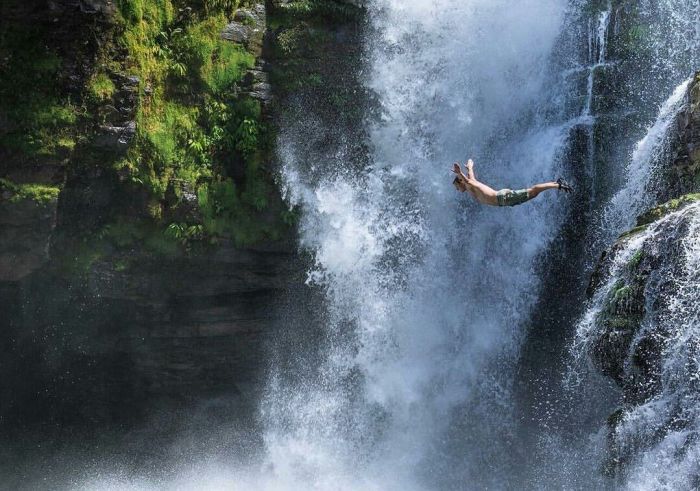
While the top 10 cliff jumping spots offer breathtaking views and thrilling experiences, there are numerous hidden gems around the world waiting to be discovered. These lesser-known locations provide similar adrenaline-pumping adventures while offering a unique and less crowded experience.
Embark on a quest to find your own personal cliff jumping paradise, where you can truly connect with nature and push your limits.
Alternative Cliff Jumping Locations
These alternative destinations offer stunning views, exhilarating jumps, and a chance to escape the crowds. Each location provides a unique experience, from secluded waterfalls to towering cliffs overlooking vast landscapes.
So, you’re into cliff jumping, huh? That’s pretty rad! There are some epic spots all over the world, from the Caribbean to the Mediterranean. Speaking of the Mediterranean, you might want to check out Greece. They’ve got some killer beaches, ancient ruins, and a whole lot of history.
You can find a list of the Top 20 Places To Visit In Greece online. Maybe you can even find some hidden cliff jumping spots while you’re there! Just remember to be safe and know your limits.
- The Nugget, Lake Tahoe, USA:This iconic rock formation in Lake Tahoe offers several cliff jumping spots ranging in height from 10 to 40 feet. The crystal-clear water and dramatic scenery make it a popular spot for thrill-seekers and nature enthusiasts.
- The Devil’s Slide, Montana, USA:Located in the breathtaking Glacier National Park, this spot offers a variety of jumps, from small ledges to towering cliffs. The surrounding mountains and glaciers provide a stunning backdrop for your adrenaline rush.
- The Blue Lagoon, Iceland:This geothermal spa offers a unique cliff jumping experience. While not as high as other spots, the warm, mineral-rich water makes it a relaxing and rejuvenating adventure.
- The Blue Grotto, Capri, Italy:This sea cave offers a thrilling cliff jump into the crystal-clear water. The cave’s unique lighting and stunning views make it a truly unforgettable experience.
- The Cliffs of Moher, Ireland:These iconic cliffs offer breathtaking views of the Atlantic Ocean. While not specifically designed for cliff jumping, the rugged coastline offers several natural platforms for a daring jump. Be sure to check for safe conditions before attempting any jumps.
Visual Inspiration
Seeing is believing, and when it comes to cliff jumping, a picture can truly capture the thrill and beauty of the experience. The images below offer a glimpse into the breathtaking landscapes and exhilarating moments that await at these top cliff jumping spots around the world.
Visual Inspiration, Top 10 Cliff Jumping Places Around The World
Visual inspiration is a crucial part of the decision-making process for cliff jumpers. It helps them visualize the jump, understand the height, and appreciate the surrounding scenery. The images below showcase the diverse and stunning locations that offer a unique and unforgettable cliff jumping experience.
| Location | Description | Image | Caption |
|---|---|---|---|
| Vik, Iceland | The rugged coastline of Vik in Iceland provides a dramatic backdrop for cliff jumping. The black sand beaches and towering basalt columns create a surreal landscape, while the crashing waves below add to the adrenaline rush. | [Image of a person jumping off a cliff in Vik, Iceland, with black sand beaches and basalt columns in the background] | The dramatic landscape of Vik, Iceland, offers a breathtaking backdrop for cliff jumping, with black sand beaches, towering basalt columns, and crashing waves. |
| La Quebrada, Mexico | La Quebrada in Acapulco, Mexico, is famous for its cliff divers who perform daring jumps from heights of up to 45 meters. The divers use the natural rock formations as platforms and execute impressive flips and twists before plunging into the turquoise waters below. | [Image of a cliff diver jumping from La Quebrada in Acapulco, Mexico, with the turquoise waters below and the surrounding cliffs] | The cliff divers of La Quebrada, Acapulco, Mexico, perform daring jumps from heights of up to 45 meters, showcasing their skills and courage against the backdrop of the stunning coastline. |
| The Bosphorus Strait, Turkey | The Bosphorus Strait in Istanbul, Turkey, offers a unique cliff jumping experience with its historic backdrop. The strait separates Europe from Asia and is lined with ancient castles, mosques, and palaces. Jumpers can enjoy breathtaking views of the city skyline while taking the plunge. | [Image of a person jumping off a cliff into the Bosphorus Strait, with the city skyline of Istanbul, Turkey, in the background] | The Bosphorus Strait in Istanbul, Turkey, provides a unique cliff jumping experience with its historic backdrop and breathtaking views of the city skyline. |
| The Blue Lagoon, Croatia | The Blue Lagoon in Croatia is a hidden gem that offers crystal-clear turquoise waters and stunning cliffs for jumping. The lagoon is surrounded by lush vegetation and is a popular destination for swimming, snorkeling, and cliff jumping. | [Image of a person jumping off a cliff into the Blue Lagoon in Croatia, with crystal-clear turquoise waters and lush vegetation surrounding the lagoon] | The Blue Lagoon in Croatia offers a hidden gem for cliff jumping, with crystal-clear turquoise waters, stunning cliffs, and lush vegetation surrounding the lagoon. |
Conclusion
Cliff jumping is an exhilarating and rewarding activity that offers a unique perspective on the world’s natural beauty. However, it’s crucial to remember that safety should always be the top priority. From choosing the right spot to mastering the proper techniques, responsible cliff jumping requires careful planning and preparation.
This involves understanding the risks, respecting the environment, and adhering to local regulations.
Responsible Cliff Jumping Practices
The thrill of cliff jumping should never come at the expense of safety or environmental integrity. Here are some key takeaways to ensure your adventures are both exciting and responsible:
- Always prioritize safety. Assess the height, water depth, and potential hazards before jumping. Never jump alone, and inform someone about your plans.
- Respect the environment. Leave no trace of your presence, and avoid disturbing wildlife or fragile ecosystems. Pack out everything you pack in.
- Adhere to local regulations and guidelines. Some areas may have restrictions or require permits for cliff jumping.
- Embrace responsible tourism. Support local communities and businesses, and contribute to the conservation of the natural resources you enjoy.
By following these guidelines, you can experience the thrill of cliff jumping while ensuring the safety of yourself and others, and the preservation of the natural world for generations to come.
Conclusive Thoughts
From the majestic cliffs of Norway to the tropical shores of the Caribbean, the world offers a diverse array of cliff jumping destinations. Whether you’re a seasoned daredevil or a first-time jumper, remember to prioritize safety and respect the environment.
By following the guidelines and tips provided in this article, you can experience the thrill of cliff jumping responsibly and create unforgettable memories that will last a lifetime. So, embrace the adventure, take the plunge, and discover the exhilarating world of cliff jumping!
Commonly Asked Questions
What are the best times of year to go cliff jumping?
The best time to go cliff jumping is during the summer months when the weather is warm and the water is calm. However, it’s important to check the local weather conditions and water temperatures before you go. Some locations may have specific seasons when the water is clearest or the weather is most favorable.
What should I wear when cliff jumping?
It’s recommended to wear comfortable clothing that you can move freely in. A swimsuit or shorts are ideal for jumping into the water. Consider wearing a rash guard or wetsuit for added protection from the sun and water.
It’s also a good idea to wear water shoes or sandals to protect your feet from sharp rocks or coral.
Is cliff jumping legal everywhere?
The legality of cliff jumping varies depending on the location. Some places may have specific regulations or permits required for jumping. It’s always best to check with local authorities or park rangers to ensure that cliff jumping is allowed and to understand any rules or restrictions.
What if I’m afraid of heights?
If you’re afraid of heights, it’s important to start with a lower cliff and gradually work your way up. Don’t force yourself to jump from a height that makes you uncomfortable. Remember, there’s no shame in taking your time and building up your confidence.
What are some tips for beginners?
Start with a lower cliff and gradually work your way up. Don’t force yourself to jump from a height that makes you uncomfortable. Practice your technique on land before jumping into the water. Make sure to check the water depth and identify any potential hazards.
Always jump with a buddy and let someone know where you’re going.
